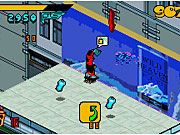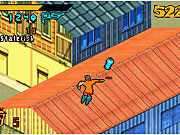Jet Grind Radio Review (original) (raw)
If you’re looking for a legal way to deface property with graffiti, and not necessarily the most complex skating game around, then Jet Grind Radio is right up your alley.
Jet Grind Radio isn't your typical skating game. Instead of racking up points by performing tricks, the big reward comes from defacing property with spray paint. The ultimate goal is to take turf away from four other rival gangs by spreading your tags throughout their territory. Along the way, rival gang members, the cops, and even government helicopters will try to stop your expansion. Jet Grind Radio originally appeared on Sega's now-defunct Dreamcast console and later received a sequel on Microsoft's Xbox. The GBA version is a hybrid of the two--It combines the level structure and characters from the Dreamcast game with many of the story elements from the Xbox game, and it does an effective job.

You need to mimic the directional motions displayed on the screen in order to spray graffiti.
THQ hired Vicarious Visions to develop Jet Grind Radio, the same company responsible for the handheld versions of Activision's popular Tony Hawk's Pro Skater series. Not surprisingly, Jet Grind Radio looks and plays like a simplified version of Tony Hawk's Pro Skater. Each neighborhood is rendered from an isometric viewpoint that makes 2D graphics appear three-dimensional. You can skate anywhere you like and use many of the objects in the environment to boost yourself into hard to reach areas. Skating is accomplished by pushing forward on the directional pad, while the buttons allow you to jump, spin, and perform a small selection of pre-programmed tricks. Many of the complicated moves that you'll find in the Tony Hawk series--such as manuals, re-verts, and multi-twist tricks--aren't possible here. The trick repertoire is perfectly sufficient to allow you to reach the spots you need to reach, but not nearly as diverse as what you'll find in traditional skateboarding games.
In addition to the modest trick selection, there are two key aspects that set Jet Grind Radio apart from other skating games. First, grinding is automatic in Jet Grind Radio. Whenever you land on a rail, you don't need to perform a trick to grind along it. This makes it easy to transfer onto rooftops and to spiral down rail structures, since you never have to worry about wasting time by building up speed or holding your balance. The other difference involves graffiti. Each neighborhood has numerous tag spots located all over. It's your job to pass next to them and scrawl your artwork. In some cases, this simply involves tapping the A button while skating by. Most of the time, however, you'll need to stop and press the directional pad multiple times in order to draw large, complex tags. As easy as it all sounds, you have to complete each area within a set time limit and stay away from any police and military personnel you encounter. You also need to keep your stock of paint cans full, which you do by collecting cans scattered around each level.
All in all, Jet Grind Radio is just as enjoyable on the GBA as it was on meatier consoles. The game’s 15 levels grow in size and difficulty at a reasonable pace. Early on, you have free run of large open areas that give you numerous chances to perform tricks, grind, and spray your tags. By the last few levels, you’ll need to transition between multiple neighborhoods during a single run and tag dozens of targets -- all while avoiding multiple SWAT teams, tanks, and helicopters. Every other level or so, you also have to deal with challenges from rival graffiti artists. If you can perform the moves they show you or beat them to a tag spot at the other end of the city, they’ll join your team. Each character has different speed, stamina, and spraying abilities, which means that new teammates are always welcome.
Obviously, the GBA isn’t on the same level in terms of visuals or audio as either the Xbox or the Dreamcast. There aren’t as many pedestrians standing around the neighborhoods in the GBA game as there were in the console versions, and most vehicles sit in one spot while they launch their missiles. Despite a list of necessary shortcuts, the GBA version of Jet Grind Radio brings through some of the better aspects from the console versions. The city layouts are large, both vertically and horizontally. It’s rare that you won’t need to climb stairs or transfer from ramps to reach rooftops. The skater animation is pretty smooth too. Vicarious Visions kept the cel-shaded look of the console game and it really seems at home here. None of the speech present in the console versions made it into the GBA version, but the seven music clips that provide the background audio are perfect, clear replicas of their console counterparts. The sound effects are also nice and crisp.

Grinding can take you onto the rooftops.
Jet Grind Radio is an easy game to get pulled into, but how long it lasts will depend on your tastes. The story mode can take a solid weekend to complete; and a bit longer if you want to finish all four neighborhoods with the highest ratings--so as to unlock all of the hidden skaters. There are also icons hidden within each level that you can collect in order to increase the number of graffiti tags you can spray. You can adjust the three main graffiti tags used within the game, as well as create a single custom tag of your own. After you complete the story mode within each neighborhood, you have the option to participate in three different time attack modes within that location. Each mode involves accomplishing a different goal -- tagging an entire city, racing an opponent, or performing tricks -- within a set time limit. There’s also a four-player multiplayer mode that lets you try these challenges against your friends, which is great fun as long as each player is similarly skilled.
THQ has done a wonderful job bringing Jet Grind Radio to the Game Boy Advance. All of the game’s shortcomings are the same ones you’ll find in the console versions. Mainly, this isn’t a complex take on skating, but a graffiti-oriented action game with skating as one of its key elements.